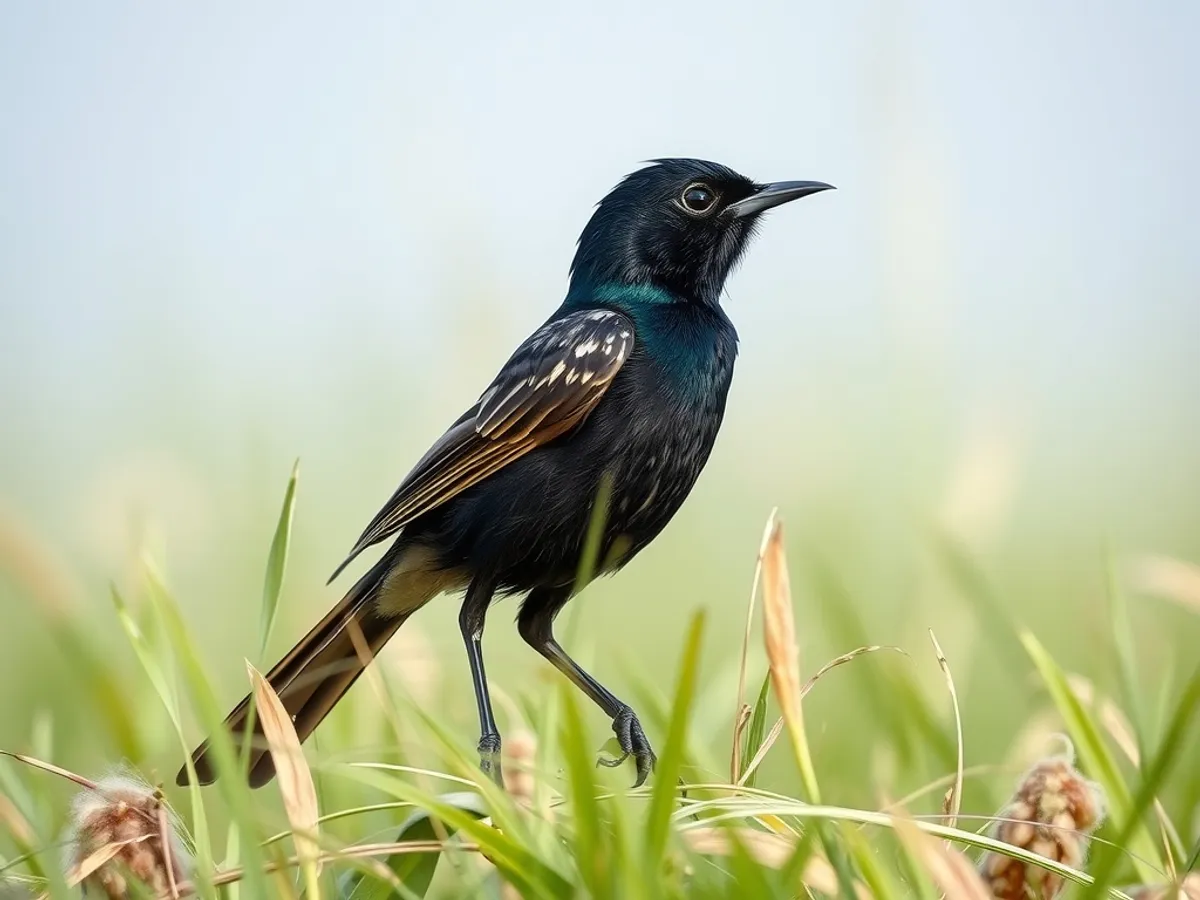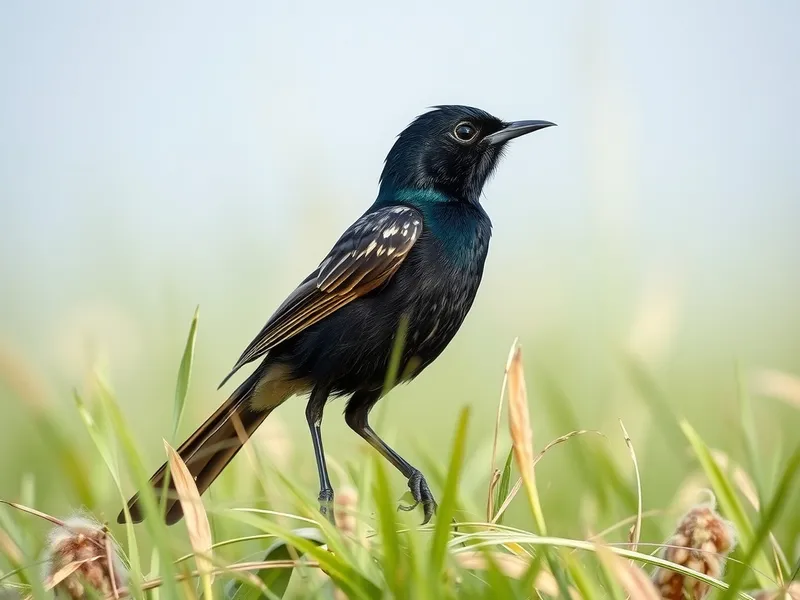
Long-tailed Widowbird
Euplectes progne

Meet the Long-tailed Widowbird
The Long-tailed Widowbird is a strikingly beautiful bird native to the grasslands of southern Africa. Males are famous for their extraordinary breeding plumage, featuring a gleaming black body and a dramatically elongated tail that can be up to half a meter long. Females and non-breeding males are more subdued, with brown and buff coloration that helps them blend into their grassy surroundings. These birds are highly social and form large flocks outside of the breeding season, often seen fluttering above the savanna in search of seeds and insects.
Classification
Bird
Habitat
Grassland
Diet
Omnivore
Lifespan
3-6 years
Conservation
Least Concern
Weight
25-35 grams
📖Fascinating Facts
Spectacular Tails
During breeding season, males grow tails that can reach up to 50 cm (20 inches), much longer than their body, to attract mates.
Grassland Specialist
Long-tailed Widowbirds are found primarily in the open grasslands and wetlands of southern and eastern Africa, where tall grasses provide both food and nesting sites.
Unique Courtship Displays
Males perform slow, fluttering flight displays over their territories, showing off their impressive tails to females as part of their courtship ritual.
📋Detailed Description
The Long-tailed Widowbird (Euplectes progne) is a medium-sized passerine notable for its dramatic sexual dimorphism and elaborate breeding displays. Adult breeding males measure 42–50 cm in total length, with the tail accounting for up to 40 cm—one of the most exaggerated tail-to-body ratios among birds. Their plumage is a glossy black, highlighted by vivid orange-red and white epaulets on the shoulders, and a pale bluish-white bill. Females and non-breeding males are much smaller (approximately 20 cm), with cryptic brown and buff streaking, slender bodies, and shorter tails, which provide camouflage in grassland habitats. The species is highly gregarious, forming flocks of dozens to several hundred individuals outside the breeding season. Their vocalizations include a variety of whistles, chatters, and trills, used for communication and territory defense. The long-tailed widowbird is primarily granivorous but supplements its diet with insects, especially during the breeding season. Males are polygynous and defend territories vigorously, using their long tails in aerial displays to attract females. The species is well-adapted to open grasslands, where it nests low in dense vegetation. Its striking appearance and complex social behaviors make it a subject of interest in studies of sexual selection and evolutionary biology.
💡 Did you know?
A male's tail can be up to three times the length of its body during the breeding season, making it one of the longest tail-to-body ratios of any bird.
🔬Research & Sources
Wikipedia Summary
The long-tailed widowbird is a species of bird in the weaver family Ploceidae. The species is found in Angola, Botswana, the Democratic Republic of the Congo, Kenya, Lesotho, South Africa, Eswatini, and Zambia. The long-tailed widowbird is a medium-sized bird and one of the most common in the territories it inhabits. Adult breeding males are almost entirely black with orange and white shoulders ("epaulets"), long, wide tails, and a bluish white bill. Females are rather inconspicuous, their feathers streaked tawny and black with pale patches on the chest, breast and back, narrow tail feathers, and horn-coloured bills.
Last Modified: 6/10/2025
🎭Behavior & Social Structure
Long-tailed Widowbirds are diurnal and spend much of their day foraging on the ground for seeds, grains, and small invertebrates. During the breeding season, males establish and defend territories, performing elaborate display flights at dawn and dusk. These displays involve slow, fluttering flights with the elongated tail streaming behind, often accompanied by vocalizations and wing flapping to attract females and deter rival males. Outside the breeding period, widowbirds form large, loose flocks that forage and roost communally, providing safety in numbers. Social hierarchies are evident within flocks, with dominant males often securing the best feeding sites. The species is known for its adaptability, shifting feeding times and locations in response to weather and food availability. Predation risk from raptors and terrestrial mammals influences their vigilance and flocking behavior.
👶Reproduction & Life Cycle
Breeding occurs during the rainy season, typically from November to April, when grass growth provides optimal nesting cover. Males are polygynous, each defending a territory that may attract multiple females. The male’s display flights and tail length are key factors in female mate choice, a classic example of sexual selection. Females construct deep, cup-shaped nests low in tall grasses, using woven grass stems and lining them with softer materials. Clutch size ranges from 2 to 4 eggs, which are pale blue or greenish. Incubation is performed solely by the female and lasts about 12–14 days. After hatching, the female continues to care for the chicks, feeding them a diet rich in insects for rapid growth. Fledging occurs after 14–17 days, but juveniles remain dependent on the female for several weeks. Males do not participate in parental care.
🛡️Adaptations & Survival
The most conspicuous adaptation is the male’s extraordinarily long tail, which is a product of sexual selection. While energetically costly and increasing predation risk, the tail serves as an honest signal of male fitness to potential mates. Both sexes exhibit cryptic coloration outside the breeding season, aiding in camouflage among grasses. Their strong, conical bills are adapted for cracking seeds, while a flexible diet allows them to exploit seasonal insect abundance. Social flocking behavior reduces individual predation risk and enhances foraging efficiency. Nest placement in dense grass provides protection from ground predators and environmental extremes.
🎨Cultural Significance
The Long-tailed Widowbird is admired in southern African cultures for its striking appearance and spectacular breeding displays, often symbolizing beauty and courtship. Its dramatic tail has inspired local folklore and is sometimes referenced in traditional songs and stories. Birdwatchers and ecotourists seek out this species, contributing to local economies. There are no known traditional uses of the bird in medicine or crafts, but its presence in grasslands is considered an indicator of habitat health.
🔬Recent Research & Discoveries
The Long-tailed Widowbird is a model organism in the study of sexual selection, particularly the evolution of exaggerated male traits. Landmark experiments by Malte Andersson in the 1980s demonstrated that females prefer males with artificially elongated tails, providing direct evidence for female choice driving tail evolution. Ongoing research investigates the genetic basis of tail length, the costs of ornamentation, and the balance between sexual and natural selection. Recent studies also explore the impacts of habitat change on breeding success and population genetics. The species’ social structure and communication are of interest in behavioral ecology, with new work examining the role of vocalizations and visual signals in territory defense and mate attraction.
🎥Wildlife Videos

30 Beautiful Birds With Longest Tails That Actually Exist | Wildlife Documentary | BBTV Official
Hello, and welcome to a journey like no other! Today, we're about to dive into the mesmerizing world of 30 unbelievable birds ...
BBTV Official

Widowbird Jumping Competition | Planet Earth II | BBC Earth
Welcome to BBC EARTH! The world is an amazing place full of stories, beauty and natural wonder. Here you'll find 50 years worth ...
BBC Earth

Widowbirds Compete For Love In A Jumping Contest - Planet Earth II
This female widowbird will choose the male who not only jumps the highest, but also the male who can jump the longest. Coming ...
BBC America

Jumping Jackson's Widowbirds
We're jumping for love this #SundayFunDay! These male Jackson's widowbirds are trying their best to impress the ladies with ...
WildEarth

Long-Tailed Widowbird | The Show-Off Bird | AnimalEnigmas
Meet the Long-tailed Widowbird, a striking bird native to African grasslands, characterized by its glossy black plumage and long, ...
Animal Enigmas

The Astonishing Long-tailed Widowbird's Courtship
Discover the captivating courtship display of the Long-tailed Widowbird, a true marvel of nature. #Wildlife #Nature #Birds ...
Birds of the World
🌍Habitat Information
The Long-tailed Widowbird typically inhabits Grassland environments. Long-tailed Widowbirds have adapted to their environments with specialized features and behaviors.
Primary Habitat:
Grassland
More detailed habitat information will be available soon.
🛡️Conservation Status
The Long-tailed Widowbird is currently classified as Least Concern. Conservation efforts are crucial for preserving this species for future generations.
Common Threats:
- 🏠Habitat loss and fragmentation
- 🌡️Climate change impacts
- 🎯Hunting and poaching
- 🏭Human-wildlife conflict
⚠️Threats & Conservation Challenges
Currently classified as Least Concern by the IUCN, the Long-tailed Widowbird maintains stable populations across its range. However, ongoing threats include habitat loss and fragmentation due to agricultural expansion, overgrazing, and urban development, which reduce suitable grassland breeding sites. Fire regimes and invasive plant species can also alter habitat structure. Pesticide use may reduce insect prey availability during the breeding season. Despite these pressures, the species’ adaptability and broad range have so far mitigated significant population declines.
🔬Scientific Classification
Scientific Name
Euplectes progne
Classification Hierarchy
🔍 About Taxonomic Classification
Taxonomic classification is a hierarchical system used by scientists to classify and organize living organisms based on shared characteristics and evolutionary relationships.
The system moves from broad categories (Kingdom) to increasingly specific ones, with each animal's scientific name typically consisting of its Genus and species.
📝Community Notes
Share your observations and insights about the Long-tailed Widowbird with our community of wildlife enthusiasts.
Join Our Community
Sign in to share your observations and connect with fellow wildlife enthusiasts.
Sign In to ContributeNo community notes yet
Be the first to share your observations about the Long-tailed Widowbird!
Explore Long-tailed Widowbird
Select a tab above to learn more about this amazing animal.
📸Photo Gallery
No photos available for this animal yet.
🌟Discover More Wildlife
Continue your journey of discovery with more fascinating animals from our database
